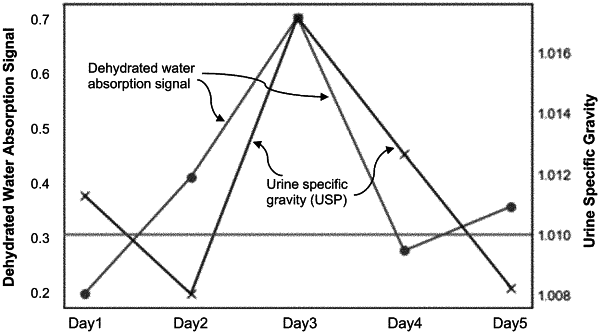| CPC A61B 5/4875 (2013.01) [A61B 5/0075 (2013.01); A61B 5/443 (2013.01); A61B 5/6831 (2013.01); A61B 5/6833 (2013.01); A61B 5/746 (2013.01); A61B 5/4261 (2013.01); A61B 5/6813 (2013.01); A61B 5/7267 (2013.01); A61B 5/7278 (2013.01)] | 17 Claims |

|
1. A hydration monitoring system, comprising:
a sensor assembly configured to be disposed within a housing having a contact surface configured to be secured against a wearer's skin, the sensor assembly comprising:
a plurality of LEDs configured to sequentially emit pulses of light through one or more light transmissive windows disposed within the contact surface toward the wearer's skin, each LED emitting at a discrete wavelength corresponding to one of a plurality of chromophores of interest;
at least one detector configured to sequentially detect pulses of light emitted by each LED, wherein the light is transmitted into, partially absorbed and reflected through the wearer's skin over a period of time, and generate signals corresponding to an intensity of detected light at each wavelength, wherein the detected light is received via the one or more light transmissive windows;
a processor/controller module configured for receiving signals from the at least one detector, at time points within the period of time;
a communication module in electrical communication with the processor/controller module; and
a power supply disposed within the housing and configured to provide power to the sensor assembly; and
an application configured to receive the signals and determine a personal hydration index (PHI) for the wearer at the time points by:
calculating average hydrated intensity values for the plurality of LEDs over an initial calibration period after wearer hydration;
collecting intensity values over a full calibration period;
normalizing the collected intensity values using the average hydrated intensity values; and
calculating average normalized collected intensity values to establish a baseline PHI for the wearer;
wherein the PHI at the time points is determined relative to the baseline PHI, and wherein the application is further configured to display the PHI at a user interface associated with the application.
|